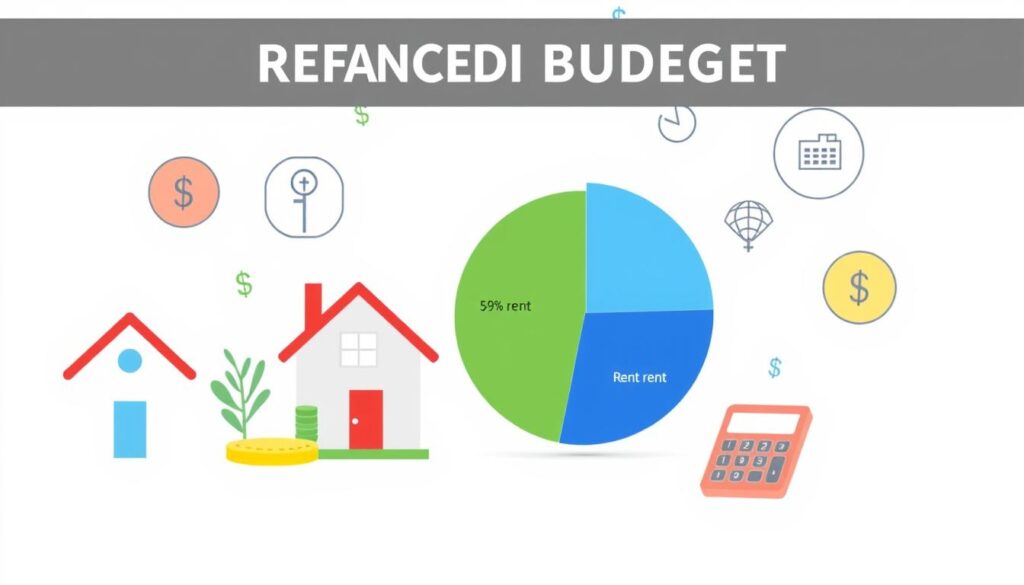In America, over 100 million people rent homes. It’s key to know how to budget for rent well. The Ramsey Solution says rent should not take up more than 25% of your take-home pay. This guide will teach you the basics of rent budgeting from Dave Ramsey.
By following the Ramsey Solution, you can make sure your rent fits with your financial goals. It helps you save money or pay off debt. This guide will show you how to budget for rent the Ramsey way.
It will also talk about what happens if you spend too much on rent. It’s important to make smart financial choices. This way, you can improve your financial health.
When you spend more than 25% on rent, it can hurt your budget. Knowing how much to spend on rent is key. It helps you secure a stable financial future.

Key Takeaways
- Understanding the ideal percentage of income to spend on rent can promote financial stability.
- The Ramsey Solution advises keeping rent costs under 25% of overall take-home pay.
- Renters should consider their total income and expenses for effective budgeting.
- The guide highlights common misconceptions about acceptable rent spending limits.
- Finding ways to reduce housing costs can significantly impact financial goals.
- Utilizing accurate budgeting methods can help renters prepare for unexpected expenses.
Understanding the Basics of Rent Budgeting
Creating a solid rent budget is key to staying financially healthy. It means knowing your monthly income and sorting out your expenses. Many struggle with housing costs, mainly because they don’t follow the dave ramsey rent budgeting rules. This approach suggests spending no more than 25% of your income on rent to avoid financial stress.
It’s important to know the difference between fixed and variable expenses. Fixed costs are things like rent, while variable costs include utilities, food, and fun. The rent affordability ramsey method is a helpful guide to ensure you spend within your means. By looking at your spending habits, you can focus on what’s really important.
Many people struggle with debt. The Center for Financial Services Innovation found that 51% of consumers manage their debt well. But 25% say they have too much debt, which can limit their financial freedom. It’s vital to understand the importance of budgeting, including for housing costs.
Don’t forget about health, transportation, and personal expenses when planning your budget. Dave Ramsey suggests setting aside money for health (5-10%), fun (5-10%), utilities (5-10%), and more. By following these guidelines, you can manage your finances without risking your stability.
| Income Level | Max Affordable Rent (Monthly) |
|---|---|
| $40,000 | $710 |
| $50,000 | $876 |
| $60,000 | $1,040 |
| $75,000 | $1,260 |
| $90,000 | $1,480 |
Why Renting Can Be a Smart Financial Choice
Renting is a smart financial choice for many, like those starting their careers or aiming for financial freedom. It offers flexibility unlike owning a home. Renting skips the big upfront costs like down payments and closing fees, easing financial pressure.
Dave Ramsey on renting points out homeownership’s financial weight. It includes mortgage payments, property taxes, maintenance, and insurance. Renters often pay less and avoid these homeowner costs.
- The average monthly rent is often significantly cheaper than the total cost of homeownership.
- Renters typically pay less for insurance; renters insurance costs are generally lower than homeowners insurance.
- Renting provides the freedom to relocate easily without the burden of selling a property.
- Over 100 million Americans currently rent, showing its widespread appeal and practicality.
While long-term renting might seem costly, its immediate benefits often outweigh these concerns. It helps avoid being ‘house poor,’ where a home consumes too much of a household’s budget.
Financial experts, like Dave Ramsey, suggest building an emergency fund before buying a home. Renting remains a wise choice for those preparing for real estate investments.
How Much Should You Spend on Rent?
Knowing how to manage your money is key to staying financially stable. The ramsey rule for rent spending is a good guide. It says you should spend no more than 25% of your take-home pay on rent and insurance. This helps keep your budget balanced, leaving room for other important expenses and savings.
Exploring the 25% Rule
The 25% rule is a simple way to figure out how much to spend on housing. For instance, if you make $56,000 a year, you’ll take home about $3,734 monthly. This means you can spend up to $933.50 on rent. This rule helps you avoid spending too much on housing, keeping your finances flexible.
Illustrative Examples of Rent Based on Income
Here are examples of how much rent you can afford based on your income:
| Annual Income | Monthly Income | Maximum Rent (25%) |
|---|---|---|
| $40,000 | $3,334 | $710 |
| $50,000 | $3,834 | $876 |
| $60,000 | $4,334 | $1,040 |
| $75,000 | $4,834 | $1,260 |
| $90,000 | $5,334 | $1,480 |
Sticking to these limits helps you follow the ramsey principles for a balanced budget. Many experts warn against the 30% rule, as it can upset your budget. The 25% rule helps you stay financially healthy, even with rising costs and housing challenges.
What Should Rent Be Based on Ramsey Solution
Over 100 million Americans face the big decision of renting a home. The Ramsey Solution helps them determine rent with Ramsey rule. It’s all about keeping rent affordable. Ideally, rent should not exceed 25% of your take-home pay.
This rule ensures you stay financially healthy while managing housing costs.
| Annual Income | Monthly Take-Home Pay | Maximum Rent (25% of Income) |
|---|---|---|
| $40,000 | $2,800 | $700 |
| $50,000 | $3,334 | $834 |
| $56,000 | $3,734 | $933.50 |
| $60,000 | $4,000 | $1,000 |
| $75,000 | $5,000 | $1,250 |
| $90,000 | $5,500 | $1,375 |
Comparing this to the “30% rule” shows why 25% is better. Sticking to 25% helps you avoid being “house poor.” This means you won’t have to worry about not having enough money for other things.
Being smart with money now can help you later, like when you want to buy a home. If you have a mortgage, keep payments under 25% of your income. With rising rents due to inflation and competition, using the rent affordability Ramsey method is a smart move.
Common Myths About Rent and Budgeting
Knowing how to budget for rent can prevent big financial mistakes. Many people believe in myths that confuse and harm their finances. By looking into these myths, people can make better choices about their housing costs. The dave ramsey rent guidelines offer a smart way to budget, helping to reduce stress and improve financial health.
Debunking the 30% Rule
The idea that spending 30% of your income on rent is okay is a common myth. This rule is outdated and has misled many, causing financial problems. The dave ramsey rent guidelines suggest a maximum of 25% of take-home pay for rent. This helps save money and reduces financial stress.
Why Many People Exceed the 25% Threshold
Even though 25% is a better goal, many pay more than that. Several reasons explain this:
- Inflated housing markets in urban areas drive costs up.
- Societal pressure to maintain a certain lifestyle fosters overspending.
- Many believe that increased spending equates to increased family happiness, reflecting misconceptions about financial responsibility.
Paying more than the dave ramsey rent guidelines can make people feel financially strained. This can lead to debt and less flexibility in the budget. It’s important to find a balance between living expenses and budgeting. This helps achieve long-term financial goals, showing the need for financial education and awareness of overspending pitfalls.
| Income Level | Recommended Rent (25%) | Traditional Rent (30%) |
|---|---|---|
| $40,000 | $833 | $1,000 |
| $60,000 | $1,250 | $1,500 |
| $80,000 | $1,667 | $2,000 |
| $100,000 | $2,083 | $2,500 |
By challenging the 30% rule and focusing on the 25% guideline, renters can manage their finances better. Understanding these myths helps take control of housing costs. This proactive approach ensures financial health remains a priority.
Utilizing the Zero-Based Budgeting Method
More than 100 million people in America rent homes. The zero-based budgeting method, backed by Dave Ramsey, is key for them. It means every dollar earned has a purpose in the budget.
This method helps renters stay within their means. For instance, if someone makes $56,000 a year, they shouldn’t pay more than $933.50 a month in rent. Here are more rent guidelines for different incomes:
| Annual Income | Maximum Monthly Rent |
|---|---|
| $40,000 | $710 |
| $50,000 | $876 |
| $60,000 | $1,040 |
| $75,000 | $1,260 |
| $90,000 | $1,480 |
Spending more than 25% of your income on rent can be tough. It makes saving and paying off debt hard. The zero-based budgeting method helps avoid this problem.
By using this method, it’s wise to keep $100 to $300 in savings. Also, give about 10% of your income to charity. The goal is to have your income minus expenses equal zero. This encourages smart money habits.

Tips for Finding Affordable Rent
Finding affordable rent with Ramsey strategy means making smart choices. Using the right tips for affordable renting can save you a lot of money. Here are some practical ways to find a more affordable place to rent.
Consider Roommates to Lower Costs
Sharing living costs can make rent more affordable. Having a roommate can cut your monthly expenses in half. For example, in a two-bedroom apartment, costs can go from over $1,200 to about $687 per person. This can save you around $6,396 a year.
Assessing Cheaper Locations for Renting
Looking for cheaper areas can save you a lot on rent. Moving to a less expensive area can save over $1,000 a month. This means you can save more than $12,000 a year. Being flexible with your location can help you find affordable rent.
Calculating Rent Using Ramsey Principles
Figuring out how much rent you can afford involves looking at your monthly income and expenses. Knowing these helps you decide on a budget for housing. This way, you can make smart choices about where you live.
Detailing Your Monthly Take-Home Pay
Your monthly income is key to figuring out rent costs. The Ramsey method suggests keeping rent under 25% of your income. Here’s a table showing the maximum rent based on your salary:
| Annual Salary | Maximum Suggested Monthly Rent |
|---|---|
| $40,000 | $710 |
| $50,000 | $876 |
| $56,000 | $933.50 |
| $60,000 | $1,040 |
| $75,000 | $1,260 |
| $90,000 | $1,480 |
Other Expenses to Consider When Renting
When using the Ramsey method, remember to include extra costs of renting. These can be utilities, transportation, and renters insurance. Keeping these in mind helps you stay within budget.
Spending more than 25% of your income on rent can lead to financial trouble. It’s important to evaluate your finances carefully before renting. This ensures you meet your housing needs now and your financial goals later.
Exploring Rent Affordability Using the Ramsey Method
Checking if a rental fits your budget is key. The Ramsey Method looks at your whole budget to make sure rent doesn’t hurt your finances. It’s a rule of thumb that rent should not be more than 25% of your monthly income. This helps you keep your finances in check.
To see if a house is affordable, you need to look at your income, expenses, and savings goals. Making a budget helps you understand how much you can afford. Here’s a table showing how much rent you might afford based on your income:
| Monthly Take-Home Pay | Maximum Recommended Rent (25%) |
|---|---|
| $2,000 | $500 |
| $3,000 | $750 |
| $4,000 | $1,000 |
| $5,000 | $1,250 |
Good budgeting means saving for emergencies and long-term goals. Starting with an emergency fund of $1,000 is a good idea. Saving 3-6 months’ worth of expenses is also recommended. This helps you deal with unexpected costs while looking for affordable rent.
The Ramsey Method helps you find the right rental and teaches you to manage your money well. It sets you up for a successful financial future.

Adjusting Your Budget to Fit Rental Costs
Renting needs careful financial planning. It’s key to adjust your budget for rent to stay financially balanced. Many expenses can affect your rent budget, so it’s important to review your financial priorities. Knowing these common expenses helps you decide how much rent you can afford.
Common Expenses That May Affect Your Rent Budget
When planning your budget for rent, think about these regular costs:
- Utilities: The average household spends about $37 on natural gas, $129 on electricity, and $58 on water and public services each month.
- Groceries: Singles spend $314 to $371 monthly, couples about $685, and families of four around $971.
- Transportation: Fuel and oil costs average $179 monthly, with extra transportation costs almost $38 monthly.
- Healthcare: Health expenses, including services and medicine, are about $130 monthly.
- Emergency Fund: It’s smart for landlords to save for unexpected repairs or maintenance, aiming for a $1,000 starter fund.
It’s important to keep housing costs below 25% of your take-home pay. By adjusting your budget for rent, you can match your daily expenses with your rental commitments.
| Expense Category | Average Monthly Cost |
|---|---|
| Natural Gas | $37 |
| Electricity | $129 |
| Water and Public Services | $58 |
| Groceries (Single) | $314 – $371 |
| Transportation | $179 |
| Healthcare | $130 |
Long-Term Financial Goals and Renting
Renting is a common choice, with over 100 million people in America choosing it. It offers flexibility but needs to align with long-term goals. Planning carefully can help move towards homeownership or big investments without financial hurdles.
When planning finances, rent is a key factor. Experts say rent should not be more than 25% of your monthly income. For example, if you make $56,000 a year, your rent should not be over $933.50 a month. Sticking to this rule helps maintain financial stability and allows for saving for the future.
Some suggest the 30% rule for rent, but spending too much can harm your finances. The 50/30/20 rule might seem good but could hurt long-term savings. It’s important to balance your current life with your future goals, ensuring your rent doesn’t harm your financial health.
In places with high rents, moving to less expensive areas can save a lot of money. This approach helps manage costs and supports long-term financial goals. Saving for a home typically requires a 5-10% down payment, showing the need for disciplined saving.
Managing rent while aiming for long-term goals requires careful planning and budgeting. Effective budgeting helps renters prepare for future stability, aligning their current costs with their dreams of homeownership or big investments.
Conclusion
Understanding rent budgeting is key to financial stability. The ramsey solution highlights the importance of knowing your finances. It suggests rent should not be more than 25% of your take-home pay.
By using simple budgeting methods, you can manage your rent well. This helps you plan for the future.
A person making $50,000 should aim for a rent of about $876 monthly. This ensures it fits with their financial plan. Knowing the limits and avoiding common mistakes is important.
Using zero-based budgeting helps you track every dollar. This keeps you on track with your financial goals.
Following these guidelines helps you control your current rent situation. It also prepares you for future financial health. Whether you’re looking to buy a home or stay in the rental market, these principles are essential.